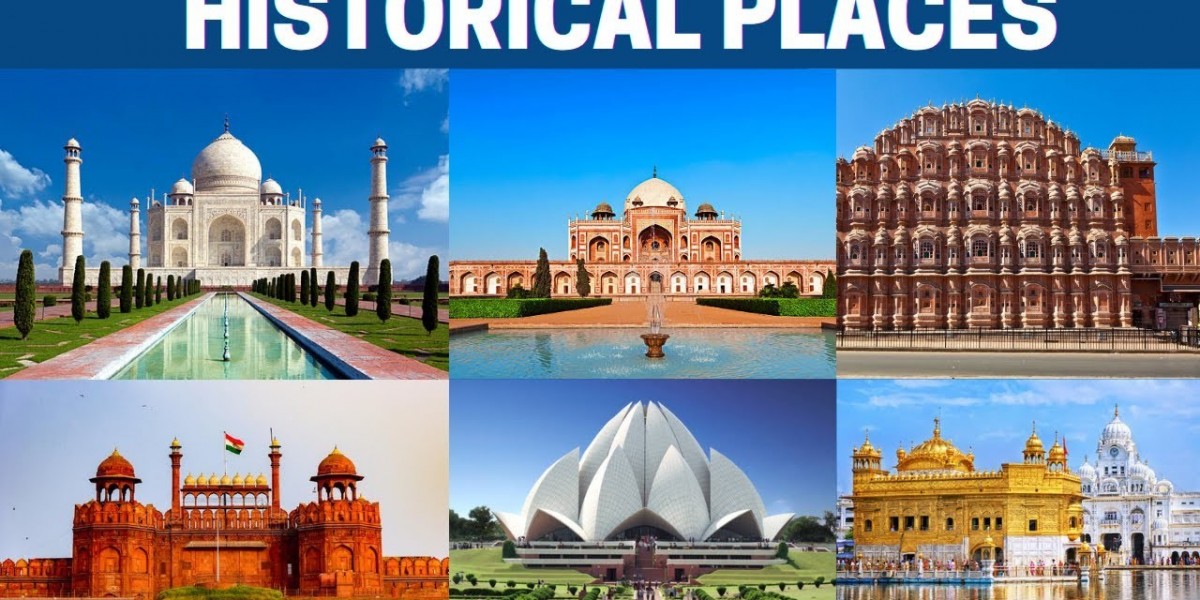India, a land of diverse cultures and rich heritage, is home to some of the world's most fascinating historical sites. From ancient temples and grand forts to colonial-era monuments and prehistoric caves, the country offers a deep dive into history at every turn. Whether you are a history buff, a traveler, or someone keen on exploring India's glorious past, this guide will take you through some of the must-visit historical places in India.
1. Taj Mahal, Agra
One of the Seven Wonders of the World, the Taj Mahal stands as an epitome of love and Mughal architecture. Built by Emperor Shah Jahan in memory of his beloved wife Mumtaz Mahal, this white marble mausoleum is a UNESCO World Heritage Site and a globally recognized symbol of India. The intricate carvings, Persian calligraphy, and the stunning reflection in the Yamuna River make it a breathtaking sight.
2. Red Fort, Delhi
A magnificent piece of Mughal architecture, the Red Fort in Delhi is a must-visit for history enthusiasts. Built in the 17th century by Emperor Shah Jahan, this fort served as the main residence of the Mughal emperors. The forts impressive red sandstone walls, beautiful gardens, and the iconic Lahori Gate make it a historical treasure. It is also the site where India's Prime Minister hoists the national flag on Independence Day.
3. Jaipurs Amer Fort
Perched on a hilltop, the Amer Fort in Jaipur is a stunning example of Rajput architecture. Built in the 16th century by Raja Man Singh, this fort is known for its artistic blend of Hindu and Mughal styles. The fort boasts magnificent palaces, intricate mirror work, and grand courtyards, making it a key historical attraction in Rajasthan.
4. Qutub Minar, Delhi
The Qutub Minar, a UNESCO World Heritage Site, is the tallest brick minaret in the world. Built in the early 13th century by Qutb-ud-din Aibak and later completed by his successors, this towering structure stands at 73 meters. It features intricate carvings and verses from the Quran, showcasing the brilliance of Indo-Islamic architecture.
5. Fatehpur Sikri, Uttar Pradesh
A former capital of the Mughal Empire, Fatehpur Sikri is an architectural masterpiece built by Emperor Akbar in the 16th century. This UNESCO-listed site includes grand structures like Buland Darwaza, Panch Mahal, and Jama Masjid, reflecting the fusion of Hindu and Islamic architectural styles. The abandoned city remains a timeless testament to Akbar's vision and grandeur.
6. Hampi, Karnataka
Hampi, a UNESCO World Heritage Site, was once the capital of the Vijayanagara Empire. The ruins of Hampi spread across vast landscapes feature grand temples, intricate carvings, and royal enclosures. The Virupaksha Temple, Lotus Mahal, and Vittala Temple with its musical pillars are highlights of this historic site.
7. Khajuraho Temples, Madhya Pradesh
The Khajuraho Temples, famous for their intricate erotic sculptures, are among the finest examples of Indian temple architecture. Built between the 9th and 11th centuries by the Chandela dynasty, these temples are a blend of Hindu and Jain traditions. The carvings depict various aspects of life, including love, war, and spirituality.
8. Sun Temple, Konark
The Sun Temple in Konark, Odisha, is a 13th-century architectural marvel dedicated to the Sun God, Surya. This UNESCO-listed temple is designed in the shape of a colossal chariot with intricately carved stone wheels and horses. The detailed carvings and the precision of its construction make it one of India's most remarkable historical sites.
9. Mysore Palace, Karnataka
A stunning example of Indo-Saracenic architecture, the Mysore Palace is a grand structure that once served as the royal residence of the Wodeyar dynasty. The palace is adorned with intricate carvings, stained glass windows, and magnificent chandeliers. The annual Dussehra celebrations at the palace attract thousands of visitors from around the world.
10. Gateway of India, Mumbai
A colonial-era landmark, the Gateway of India was built in 1924 to commemorate the visit of King George V and Queen Mary. Overlooking the Arabian Sea, this grand structure stands as a reminder of British colonial rule and India's struggle for independence. Today, it is a major tourist attraction in Mumbai.
11. Chittorgarh Fort, Rajasthan
The largest fort in India, Chittorgarh Fort, is a symbol of Rajput bravery and sacrifice. This UNESCO World Heritage Site was the capital of the Mewar Kingdom and has witnessed several battles. The fort houses magnificent palaces, temples, and the famous Vijay Stambh (Victory Tower), making it a must-visit for history lovers.
12. Elephanta Caves, Maharashtra
Located on Elephanta Island near Mumbai, the Elephanta Caves are a UNESCO-listed site featuring rock-cut sculptures dedicated to Lord Shiva. Dating back to the 5th7th centuries, these caves showcase intricate carvings and remarkable depictions of Hindu mythology, making them a significant historical attraction.
13. Sanchi Stupa, Madhya Pradesh
The Sanchi Stupa, built by Emperor Ashoka in the 3rd century BCE, is one of the oldest stone structures in India. This Buddhist monument features intricately carved gateways depicting the life of Buddha. It remains an important pilgrimage site for Buddhists and history enthusiasts.
14. Rani ki Vav, Gujarat
A stepwell built in the 11th century, Rani ki Vav in Patan, Gujarat, is an architectural masterpiece and a UNESCO World Heritage Site. The intricately carved walls, pillars, and sculptures depicting Hindu deities make it one of India's most exquisite historical sites.
15. Golconda Fort, Hyderabad
Once the seat of the Qutb Shahi dynasty, Golconda Fort is a marvel of military architecture. Famous for its acoustic effects, palaces, and the iconic Fateh Darwaza, this fort played a crucial role in India's history, particularly in the diamond trade.
Conclusion
Indias historical landmarks narrate tales of ancient civilizations, mighty empires, and cultural evolution. Exploring these sites offers a glimpse into the countrys glorious past and architectural brilliance. Whether its the Mughal grandeur of the Taj Mahal, the Rajputana valour of Chittorgarh Fort, or the Buddhist heritage of Sanchi, every monument has a unique story to tell. A visit to these historical places is not just a journey through time but also an enriching experience that showcases the soul of India. For more insights on such incredible destinations, check out IndianEagle, Travel Diary Blogs, and CityVillage News to stay updated with travel stories, historical insights, and cultural experiences.








